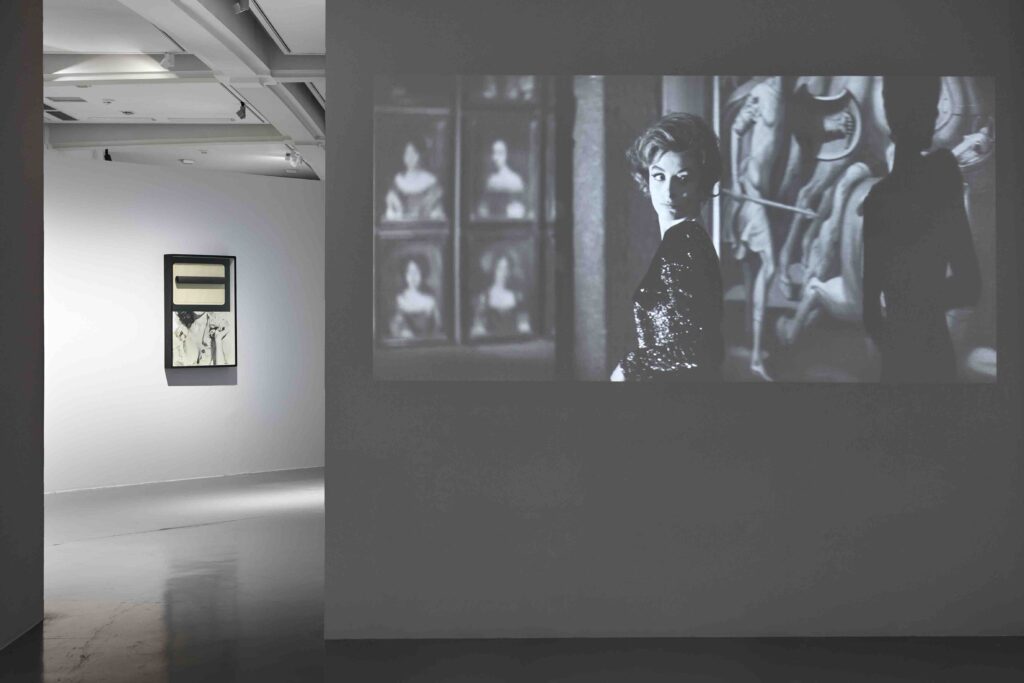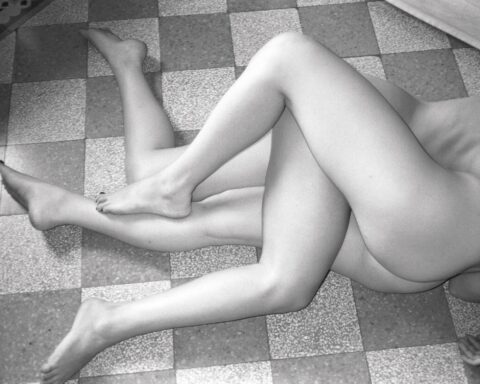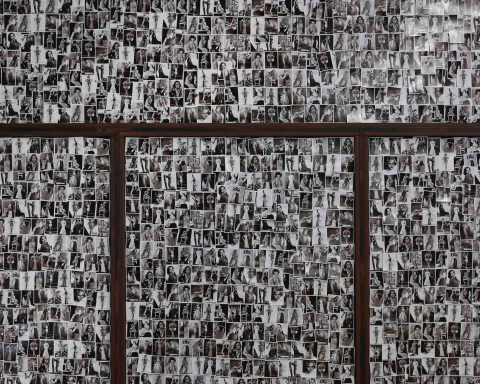A few weeks after the opening of the two major exhibitions in Nice, which narrate Italian art from 1960 to today in an unprecedented and transversal way – presenting a significant gap, that of the Eighties, not foreseen in the two exhibitions – the unexpected no extradition of the former Brigate Rosse arrested in Paris in the summer of 2021 arrives, as part of the Red Shadows operation. The rejection by the Chambre de l’Instruction of the Court of Appeal of Paris of the Italian requests allows us a return to history that becomes news, to that year 1979 which can become an ideological date that also separates the two important French exhibitions: Vita Nuova. New issues for art in Italy 1960-1975 created under the direction of Valérie Da Costa at the Musée d’Art Moderne et d’Art Contemporain de Nice and The Future Behind Us. Italian art since the 1990s: the contemporary facing the past created by Marco Scotini at Villa Arson.
1979 marks in a paradigmatic way – through the famous 7 April Process and the related Mitterrand doctrine – a close relationship between the Alps, a borderline between the struggles of the Seventies in Italy and the triumphal cavalcade of Neo liberalism which also invades the field of the visual arts with the capitalist enthusiasms of the Transavanguardia.
1979 is a year of modern Odyssey – Toni Negri, arrested, elected radical deputy and then fled into exile in Nice – of the Piazza Fontana sentence, of Margaret Thatcher victory, of the communist Nilde Iotti, the first woman to be elected President of the Italian Chamber of the Deputies, of the conquest of power of the Sandinistas in Nicaragua, of the birth of the Walkman, of the Soviet invasion of Afghanistan, of the kidnapping of Fabrizio De André, of the Conferenze Brasiliane and the real effectiveness of the Basaglia Psychiatric Reform Law (entered into force in 1978).
1979 is a year of revolutions, a symbol that tells of two different nations, which marks the transition from the wage labour market to that cognitive capitalism that marks the end of the distinction between the time of life and the time of work.
A ten-year watershed, two exhibitions to tell a story that never has a single direction, that does not present a unique and eternal reading plan, that can reclaim the past without making it postmodern and that, referring to an idea of Benedetto Croce, allows us to “present the further history of thought as a recourse to Vico’s ideas”. [Benedetto Croce, The Philosophy of Giambattista Vico [1911], Laterza, Bari 1922, p. 251]
Vita Nuova. New issues for art in Italy 1960-1975
Germano Celant was a militant critic. With his Arte Povera he gave life to a “movement” opposite to that theorized by Filippo Tommaso Martinetti: if with Futurism art entered life, with Celant life entered art. However, the birth certificate of these two fundamental artistic currents of Italian art, and not only, of the twentieth century is the same: a Manifesto.
This premise is useful for understanding Identité italienne. L’art en Italie depuis 1959, a major exhibition curated by Celant, in 1981, at the Center Pompidou National Museum of Modern Art in Paris. Not a broad reconnaissance, with a critical approach, but a militant choice, a “dissociated exhibition”- an expression recently used by Marco Scotini – which becomes a case study, an exhibition aimed at celebrating individual individualities, composed of the works of 18 highly selected artists, dissociated together with a bulimic catalog with an archival cut of 700 pages, with a chronology between 1959 and 1980.

1964 © Private collection, Milan – Courtesy The Estate of Fabio Mauri and Hauser & Wirth. Photo Jean-Christophe Lett Vita Nuova. Nouveaux enjeux de l’art en Italie 1960-1975, Exhibition viewMAMAC, Nice (May 14 – October 2, 2022)
Vita Nova. New issues for art in Italy 1960-1975 was born with very different purposes, and while keeping within a certain limit of white cube it wants to give an overall vision, not hierarchical, and tell and rediscover in a broad way the vivacity of artistic creation in Italy between 1960 and 1975, highlighting all its internal differences. Proposing it to the French public not as an alternative but as a necessary cultural and aesthetic area that supports the much more famous Arte Povera, through a device that does not become controversial, as in the texts of Luca Beatrice, but critical and historiographical.
Curated by Valérie Da Costa, art historian and specialist in Italian art, the exhibition aims to show a new vision of fifteen years of creation ranging from 1960 – a period that corresponds to the first exhibitions of a new generation of artists born between the 1920s and 1940 – to 1975, the year of the tragic death of Pier Paolo Pasolini, an author born exactly one hundred years ago, who symbolically opens and closes the exhibition project through two works that show him as the subject and object of artistic production, author and symbol (the Comizi d’amore of Pasolini, 1965 and Intellettuale. Il vangelo secondo Matteo di/su Pier Paolo Pasolini realized by Fabio Mauri, 1975).
Pasolini, source of poetic inspiration for Gianmaria Tosatti’s Italian Pavilion, becomes a non-directional device, a thematic and popular tool which, beyond becoming chronological, shows the mechanisms and returns of history, as we will see in the partner exhibition at Villa Arson.
The great exhibition of the MAMAC is excellently divided into three sections and lovingly makes up for a title that, on its first reading, proposes a too easy reference to the homonymous Dante text.

Eliseo Mattiacci, Rifarsi, 1973. Collection Mattiacci, Pesaro. Photo Andrea Solomita, Jean-Christophe Lett.
Vita Nuova. Nouveaux enjeux de l’art en Italie 1960-1975, Exhibition view. MAMAC, Nice (May 14 – October 2, 2022) MAMAC, Nice (May 14 – October 2, 2022)
The thematic approach of the exhibition project leads to three key topics, proposed through a refined and non-trivial vision: A society of images, Reconstructing nature and The body’s memory; developed by presenting the work of sixty artists, some often little known to the general public – the trans-temporal images of Lisetta Carmi and the delicate feathers, between poor art and surrealism by Maria Lai deserve great attention – and with a careful selection of one hundred and thirty works and archival documents from Italy and from public and private French collections.
A society of images develops a careful analysis of an Italy that in the sixties and seventies found itself in the balance between the birth of consumerism, a particular Pop Art attentive to the millenary culture of the nation, and the outbreak of civil protest and soon hidden under the two opposing black and red factions. These are the years of the excesses of the new Roman Hollywood of the genius of Mario Schifano but also of the discovery of sexual and gender issues, between glossy image and claim.
Reconstructing nature develops the ambiguous relationship between industrialization and nature, showing how art was one of the first fields of environmental awareness during the economic boom. The title of the section has changed from the very bright meteor by Pino Pascali, active for a couple of years before the tragic death but central to a reflection on nature that sees Piero Gilardi as his prophet. All fields of artistic production are attracted to this theme, they explore it by bringing life into art without prejudice and often seeking mediation.
The body’s memory presents the body as a tool for measuring oneself and the world, as a political agent and as an extra material means. A very successful section that leads the viewer into a fundamental theme that somehow anticipates the apical text Il Corpo, published in 1987 by Umberto Galimberti. The performative approach in those years becomes personal and collective, the culture that leads back to the discovery of the mechanisms of images, nature and the body offers art a wide range of ideas that will be covered with every possible media, making art come out from its unidirectional aura up to the creation and involvement of a new public paradigm that will be kidnapped and exploited by the Neo capitalism of the Eighties up to the trading of data that exploded in the society of networks and connections.
The Future Behind Us. Italian art since the 1990s: the contemporary facing the past

Photo n&b, Courtesy Uliano Lucas Archive. The Future Behind Us Exhibition view
Villa Arson Nice (June-August 2022). Curator Marco Scotini, Copyright Jean-Christophe Lett
Marco Scotini is not a militant critic, Scotini is a disobedient intellectual. His militant research led him to study the state of the art in post-Fordist capitalism, overcoming the legacy of the Institutional Critique in favor of a socio-labor point of view capable of bringing aesthetic production back to level of any other work, defending cognitive doing from a society of control that invades and conquers every uncoded and free space.
Creator of the exemplary Disobedience Archive, he investigated the concept of Artecrazia by dialoguing with some of the most important independent intellectuals of our time such as Paolo Virno and Maurizio Lazzarato, proposing a non-linear reading of history which in the Niçois exhibition highlights the great removal and mystification of culture of the sixties and seventies, which took place in the eighties, which today leads to a fundamental return to the art closest to us. In an era in which the concepts of class, people and race are empty and exploited by populisms, art can find that much sought-after representation of the many only if it is conveyed through a principle of deviation. Developing a rich and articulated critical thinking, Scotini shows himself as the most important curator of our contemporaneity, always elusive one step before institutionalization, very different from Germano Celant, a sort of dark side of Hans Ulrich Obrist, the maximum expression of the fallacious victory of thought of the seventies, paradigmatic “chief curator” of the cognitive industry.
The Future Behind Us is a splendid exhibition, fully Scotinian, which revolves around the concept of memory as a mechanism of action in the present. The works and the public are inserted in a time where the couple before and after it gives way to the “virtual and current” one, in a space-time where the ghosts of the past coexist with the struggles of the present.

Very different from the great MAMAC exhibition project, the exhibition conceived by Scotini chooses a peripheral location even if located in the very central and touristic Nice. Villa Arson is not a museum, it is an artistic research and innovation center, a contemporary art center, a residence for artists and a national art school. A hybrid reality, which escapes any definition. It is a labyrinthine masterpiece of brutalist architecture that grants some rooms to tell the story of Italian art produced from 1990 to the present day through the creation of twenty artistic realities united by a lack of encounter with history, by a return of a repressed not lived but present which connects them with the creative revolution of the seventies from all stolen by the return to the order of the sure and winning neo-liberalism of the eighties.

More than anachronistic, Scotini’s reading of Italian art is fluid and boundless, it invades the rooms without faith in personalities but proposing themes that are never completely defined that produce osmotic exchanges, which bring stories to life, overshadowing the fetish for the artwork. Horizontal is the relationship between audience and artist, between performer and user of aesthetic work.
A large blue horse dominates the space (Claire Fontaine, Is freedom therapeutic?), a horse without history but in history, of everyone and no one, that runs on the territories of the Carta Atopica by Luca Vitone, who plays with Franco Basaglia, who leaves perceive environmental issues, protests, media images and bodies presented at MAMAC as a sweet and bitter aftertaste.
In the rooms, key themes and figures of the birth of a new thought meet, of an incredibly full decade of revolutions, to be understood independently, investigating labels and memories, discovering and creating connections.
The first section, Divenire Ex, with a more archaeological character, leads to the rediscovery of fundamental thoughts and personalities of the Seventies through their development in current aesthetic production and prepares the public for the Esercizi di esodo section, dedicated to the themes most dear to the curator such as the transition to post-Fordist work, counter-information and non-authoritarian pedagogy. This first part of the exhibition is followed, without a chronological need, by the Vogliamo ancora tutto section where an ongoing recovery is highlighted in relation to urban and ecologist practices, in parallel with the anti-globalization movement.
It is a complex device, circularly layered and full of meanings, The Future Behind Us, a non-exhibition that in a few rooms, with a few artifacts, creates a galaxy of works that give their singularity to the total. For a second you are no longer in France, you are in a labyrinthine memory device that recalls the choral narration of the Jüdischen Museum in Berlin. The tale and the return of the repressed history overcomes the singularity of the works, making them important only in a collective reading.
The Future Behind Us is not an exhibition, it is an important odyssey of Italian contemporary art from the 1990s to today, a project that generates a representation of the many; it is Scotini’s theoretical action that materializes, narrates and involves, and fully convinces.


Bert Theis. Growing House/Shenzen, 2004. Courtesy Bert Theis Archive Luxemburg/Milano.
Massimo Bartolini. Tavolo dei 4 lampi, 2013. Courtesy the artist and Galleria Massimo de Carlo, (Milan, Paris, Hong Kong)
Massimo Bartolini. Art is Easy by Giuseppe Chiari, 1970. Courtesy Frittelli arte contemporanea, Firenze
The Future Behind Us Exhibition view, Villa Arson Nice (June-August 2022) Curator Marco Scotini, Copyright Jean-Christophe Lett










